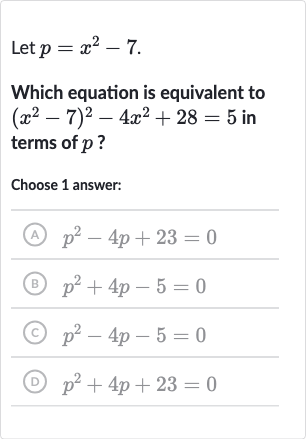Full solution
Q. Let . Which equation is equivalent to in terms of ? Choose answer: (A) (B) (C) (D)
- Substitute into equation: Given , we need to express the equation in terms of .
- Express in terms of : First, let's substitute into the equation where we see . This gives us .
- Distribute across terms: Now, we need to express in terms of . Since , we can rewrite as . Therefore, becomes .
- Simplify the equation: Substitute into the equation in place of . This gives us .
- Subtract from both sides: Now, let's distribute the across the terms inside the parentheses: .
- Express equation in standard form: The and cancel each other out, simplifying the equation to .
- Express equation in standard form: The and cancel each other out, simplifying the equation to .To get the equation in standard form, we subtract from both sides, resulting in .
- Express equation in standard form: The and cancel each other out, simplifying the equation to .To get the equation in standard form, we subtract from both sides, resulting in .We have now expressed the original equation in terms of , and the equivalent equation is , which corresponds to option .
More problems from Solve a quadratic equation by factoring
QuestionGet tutor help
QuestionGet tutor help
QuestionGet tutor help
QuestionGet tutor help
QuestionGet tutor help
QuestionGet tutor help
QuestionGet tutor help
QuestionGet tutor help

